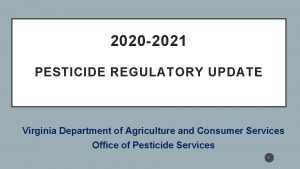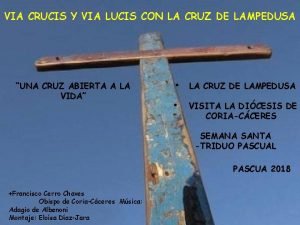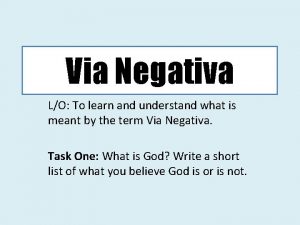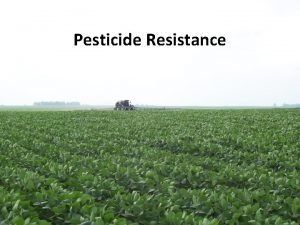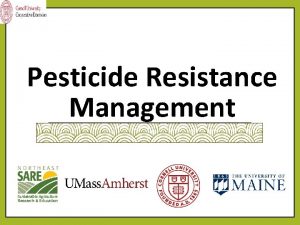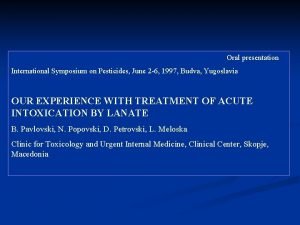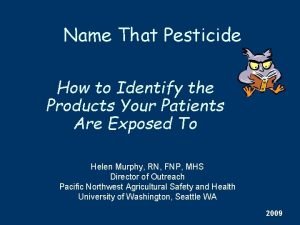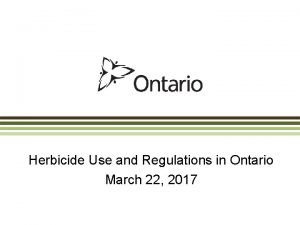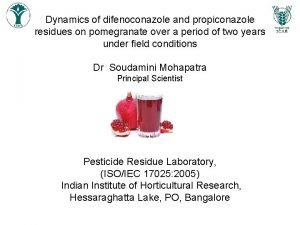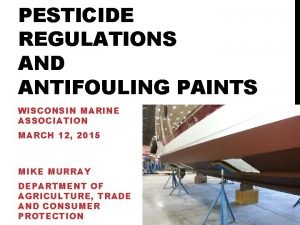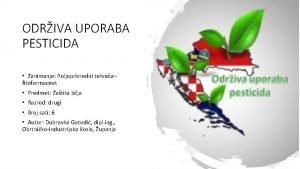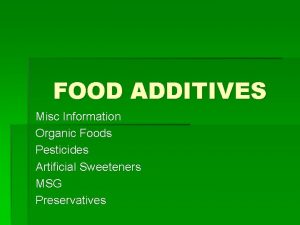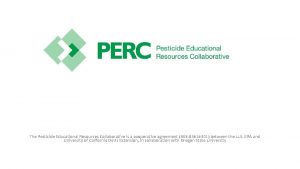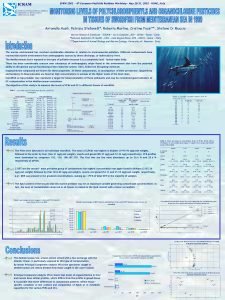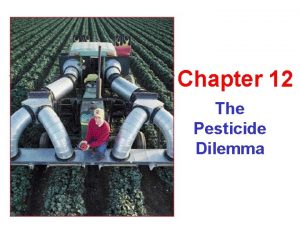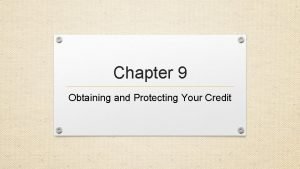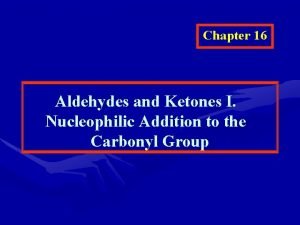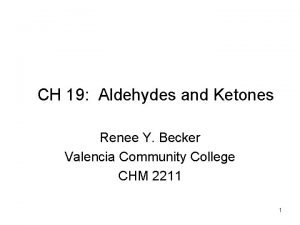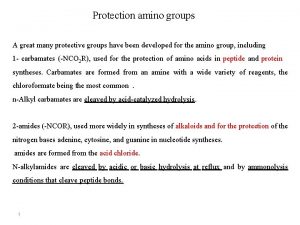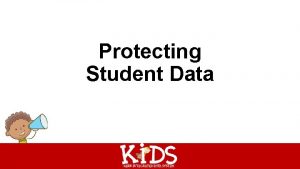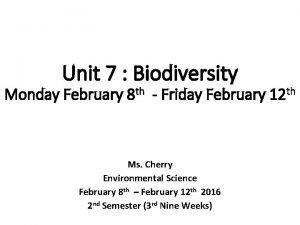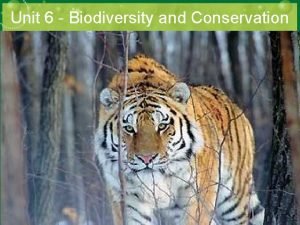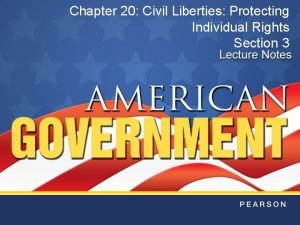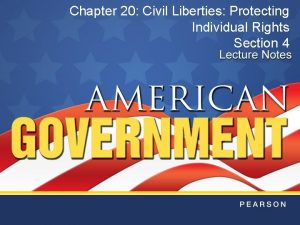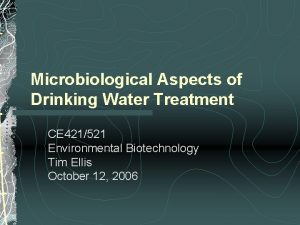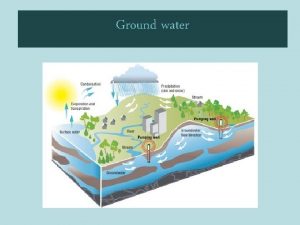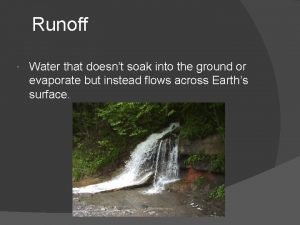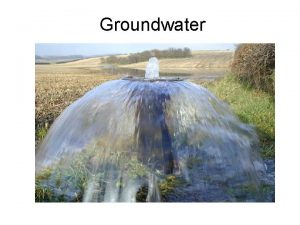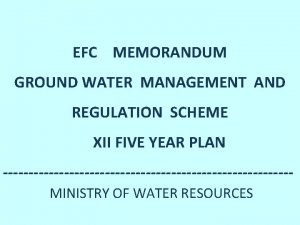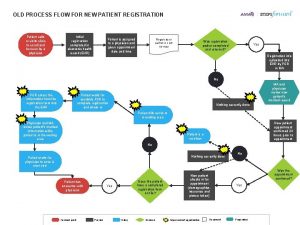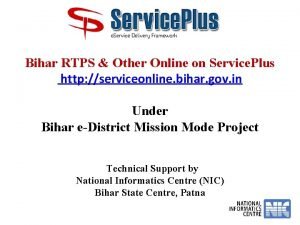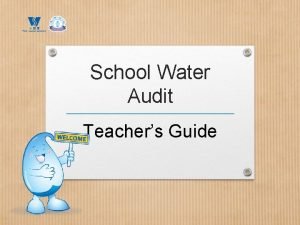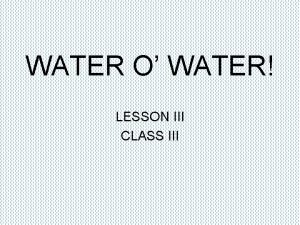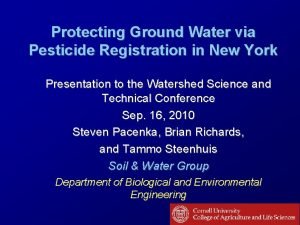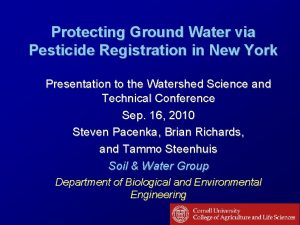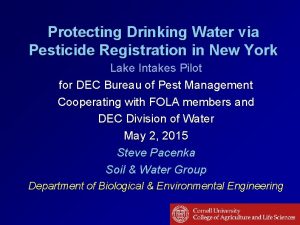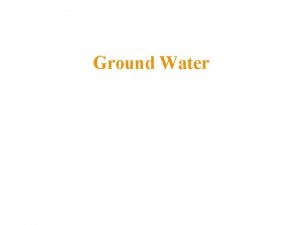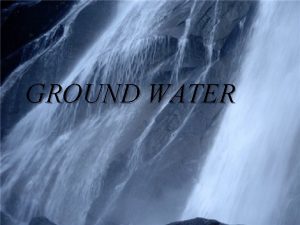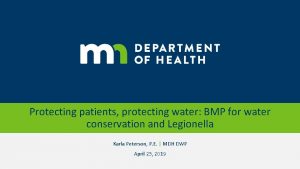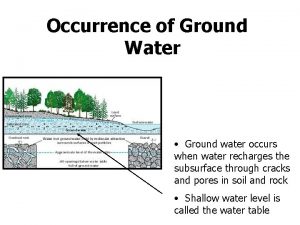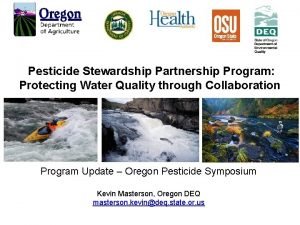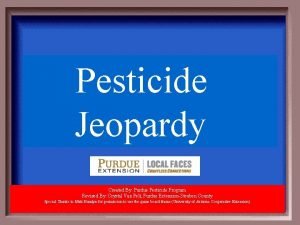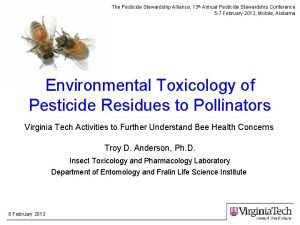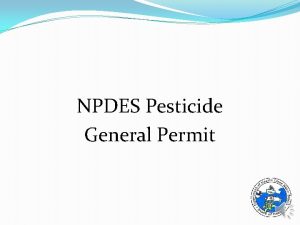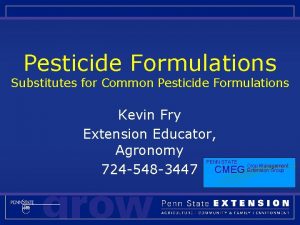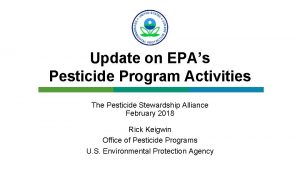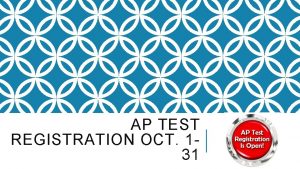Protecting Ground Water via Pesticide Registration in New
















































- Slides: 48

Protecting Ground Water via Pesticide Registration in New York Presentation to the Cornell Pesticide Users March 29, 2013 Soil & Water Group Department of Biological and Environmental Engineering

Outline Overview: Pesticides in groundwater Upstate monitoring by county Vulnerable formations: karst New initiatives Outreach

Long Island pesticide data: tracing past contamination hi Sampling intensity low

Pesticide detection patterns in Suffolk County groundwater Preliminary: Percentage of pesticide analyses reported as above detection limit From data Suffolk County submitted to New York State, 2000 -2010

Current Pesticide Use in NY Derived from New York Pesticide Sales and Use Reporting system published data.

Mobility & persistence are combined in the Groundwater Ubiquity Score (GUS) factor Low Very Low High Medium Very High * Imazethapyr * Carbofuran * Atrazine * Alachlor * Chlorothalonil * Glyphosate

Pesticide use weighted by GUS

Upstate monitoring strategy Not looking for: • Average groundwater concentrations • Spills or violations But rather sampling well water in areas deemed vulnerable due to: • high pesticide use • groundwater (soil/aquifer) characteristics that favor transport

Working premise If well water in vulnerable areas is of good quality, then we can have high confidence that well water in less vulnerable areas is also of good quality Cortland County cornfield that dominates hill above shallow wells

Outline Overview: Pesticides in groundwater Upstate monitoring by county Karst formations New initiatives Outreach

County-based sampling Genesee Wayne Cayuga Schenectady Cortland Orange Partnering with local S&WCD’s, WQCC and DOH

Testing for. . . DEC lab (to 2009): 93 active ingredients DEC lab since 2010: shorter priority list of 51 AIs and degradates (metabolites) Cornell Soil & Water Laboratory: -- Selected active ingredients using higher resolution ELISA immunoassay methods -- Nitrates, anions (IC)

Findings in six counties. . . DEC broad-based scans: One detection of one active ingredient in 240 samples (reporting limits 1 μg/L (1 ppb) or less). Degradation products detected in 5 of 41 wells tested in Wayne County No exceedance of any of 15 NYS ground water standards or guidance levels

Wayne County wells with detections or high NO 3 -N Land use: CC - corn/grain cash crop rotation O - orchards (apple) M -muckland vegetables W - wooded Depth Land Use NO 3 -N (ft) (mg/L) 1 2 Metolachlor (µg/L) OA ESA Alachlor ESA (µg/L) Atrazine (µg/L) 4 -6 O CC 14 ND < 0. 1 ND 40 -45 CC W 24 4. 6 ND < 0. 1 trace<0. 1 40 CC O ND < 0. 1 0. 2 ND < 0. 1 ND 42 CC O <0. 5 1 0. 2 0. 6 0. 1 ND 12 M CC 1 0. 2 ND < 0. 1 ND 22 CC O <0. 5 0. 1 1. 9 ND < 0. 1 trace <0. 1

Cornell ELISA assay results for select AI’s


Nitrates typical for rural NY * * SO 4 interference

Interpretation to date Upstate rural wells – even vulnerable shallow wells surrounded by fields and having elevated nitrate – are in good shape relative to current groundwater pesticide standards. There are frequent low traces of atrazine and some metolachlor in agricultural areas, as found nationally.

Ongoing county-level work Revisiting selected wells in view of: Improved DEC lab reporting limits (0. 1 ppb starting with Wayne Co. ) Addition of key pesticide degradation products (metabolites) which can have greater mobility and/or toxicity than original AI Time-of-sampling studies – repeated at several month intervals (Orange County)

Questions so far? Overview: Pesticides in groundwater Upstate monitoring by county Karst formations New initiatives Outreach

Karst (carbonate) ground water Objective: determine if karst requires special registration consideration Genesee county hydrogeologic setting Interim results

Lots of carbonate in Upstate NY Dark hatching is carbonate; Source: USGS

Karst: Solution conduits in limestone

Carbonate western NY

Genesee karst Flow in limestone; losing reaches

Genesee karst: sampling sites

Genesee karst: sampling depths Onondaga Unconf Shale

Genesee karst: 16 months overall: atrazine 5/22 detects to 0. 05 ppb 7/19 detects 0/9 detects Metolachlor similar: 6/13, 5/11, 0/6 respectively

Genesee karst: atrazine seasonality (% of samples) Jun 10 Jul 10 Sep 10 Dec 10 Sep 11 Detect >=0. 1 Trace >=0. 05 ND <0. 05 ppb

Geneva AES limestone?

Questions? Overview: Pesticides in groundwater Upstate monitoring by county Karst formations New initiatives Outreach

Looking ahead: New initiatives I - Lakeshore water supplies II - Greenhouse leaching III - DEC modeling support

Leaching Model Support Objective Assess the standard pesticide environmental fate model toolkit used in the NY registration process. Toolkit = leaching models + conservative environmental scenarios

Modeling tasks • Specify evaluation criteria with DEC • DEC staff workshop – walk through current goals, assumptions, & input scenarios • Stakeholder roundtable – solicit input on model and design scenarios

More modeling tasks • Model and scenario evaluation retrospective cases, new scenarios • DEC workshop to walk through and evaluate findings, make draft recommendations • Report with new model + scenario packages if merited

Leaching models 1980’s traditional LEACHP, PRZM

Leaching models improved 1980’s traditional LEACHP, PRZM 2000’s with preferential Flow paths, tile drains, fragipans, i. e. short circuits and lateral losses to streams

Scenarios: conservative case(s) of usage, soil, climate, and depth to ground water. Do we need new upstate scenarios? Upstate tile drains (Willsboro) Upstate carbonate (Batavia) Long Island (Riverhead)

Willsboro Farm: Atrazine measured in tile drains Concentration Versus time

Recharge Aldicarb at CU Riverhead – simulated with DEC scenario Leachate concentration

Atrazine leaching: thin soil at Batavia Atrazine leaching: Long Island

Questions? Overview: Pesticides in groundwater Upstate monitoring by county Karst formations New initiatives Outreach

Publications • Ground Water Monitoring & Remediation research articles • NY Veg Growers News Events • 2011 Empire Farm Days booth • Cornell in-service training • NY State Soil & Water Conservation Committee • September 2012 Northeast Pesticides C&T Meeting Webpage soilandwater. bee. cornell. edu/Research/pesticides/

http: //soilandwater. bee. cornell. edu/Research/pesticides/

Thanks to Funding NYS DEC NYS WRI directors Keith Porter & Susan Riha, who delegated to BEE County Partners Cortland, Schenectady, Orange, Cayuga, Genesee, and Wayne County Soil & Water Conservation Districts. Genesee County Health Dept. Many private well owners. Karst partner: Paul Richards, College at Brockport, Dept of Earth Sciences Cornell Pesticide Management Education Program for help using the PSUR database NYS Soil & Water Conservation Committee for early endorsement Cornell students Ian Toevs, Tony Salvucci, Ben Liu, Sophia Garcia, Mike Sinkevich, Ivy Tsoi, Zia Ahmed, Sheila Saia, Austin Merboth, Cedric Mason

Thank You!

Contacts Brian Richards (bkr 2@cornell. edu) Steve Pacenka (sp 17@cornell. edu) Tammo Steenhuis (tss 1@cornell. edu) http: //soilandwater. bee. cornell. edu/Research/ pesticides/

 Virginia pesticide registration
Virginia pesticide registration Water and water and water water
Water and water and water water Decimoquinta estacion del via crucis
Decimoquinta estacion del via crucis La via negativa
La via negativa Viacrucis catolico
Viacrucis catolico Via piramidal y extrapiramidal
Via piramidal y extrapiramidal Via erudita e via popular
Via erudita e via popular Pesticide resistance
Pesticide resistance Xxxxxxxxxx xxxxxxxxx
Xxxxxxxxxx xxxxxxxxx Lanate pesticide
Lanate pesticide Pesticide classification chart
Pesticide classification chart Ontario pesticide regulations
Ontario pesticide regulations Agriculture pesticide difenoconazole
Agriculture pesticide difenoconazole Wisconsin pesticide applicator license
Wisconsin pesticide applicator license Tablica miješanja pesticida
Tablica miješanja pesticida Msg pesticide
Msg pesticide Pesticide educational resources collaborative
Pesticide educational resources collaborative European pesticide residue workshop
European pesticide residue workshop Types of pesticides
Types of pesticides What is noninstallment credit
What is noninstallment credit Chapter 9 obtaining and protecting your credit
Chapter 9 obtaining and protecting your credit Chapter 20 civil liberties protecting individual rights
Chapter 20 civil liberties protecting individual rights Aldehyde protecting group
Aldehyde protecting group Ch3li
Ch3li Carbamate protecting group
Carbamate protecting group I pray you leap not to witchcraft
I pray you leap not to witchcraft Chapter 9 obtaining and protecting your credit
Chapter 9 obtaining and protecting your credit Protecting student data
Protecting student data Protecting consumers savers and investors examples
Protecting consumers savers and investors examples Single species approaches to protecting biodiversity
Single species approaches to protecting biodiversity Single species approaches to protecting biodiversity
Single species approaches to protecting biodiversity Chapter 20 civil liberties protecting individual rights
Chapter 20 civil liberties protecting individual rights Chapter 20 civil liberties protecting individual rights
Chapter 20 civil liberties protecting individual rights Groundwater pollution
Groundwater pollution Ground water treatment process
Ground water treatment process Ground water
Ground water Water that doesn't soak into the ground
Water that doesn't soak into the ground Importance of groundwater
Importance of groundwater Ground water management and regulation scheme
Ground water management and regulation scheme Digitalgujarat.gov.in school login
Digitalgujarat.gov.in school login Patient registration process flowchart
Patient registration process flowchart Calaters new user registration
Calaters new user registration Nicdsign client
Nicdsign client Water consumption water meter reading worksheet
Water consumption water meter reading worksheet Tpc kapal adalah
Tpc kapal adalah Water o water
Water o water 5 divided by 1/4
5 divided by 1/4 Class 8 english chapter 7 water water everywhere
Class 8 english chapter 7 water water everywhere Water heat exchanger
Water heat exchanger
